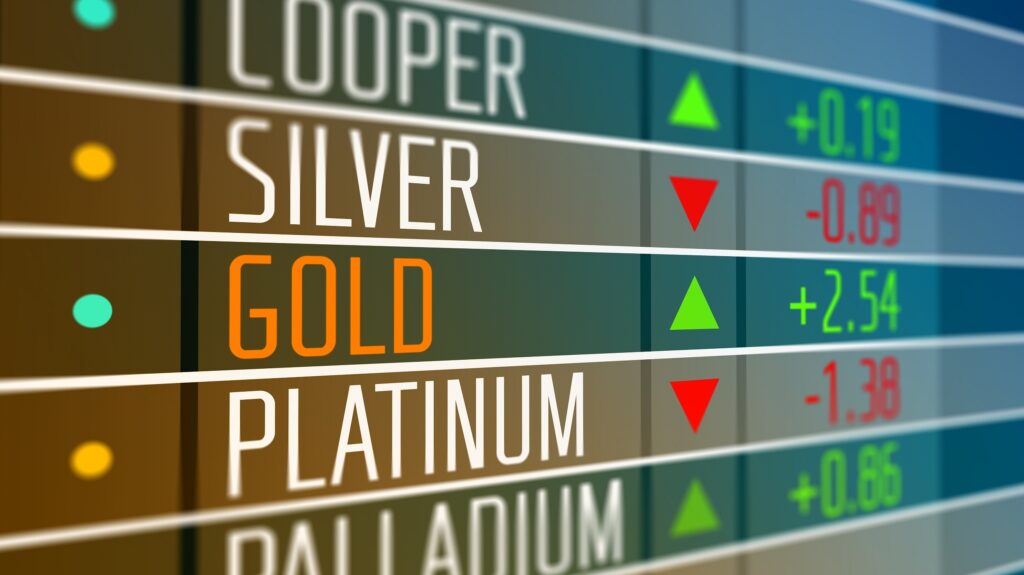What are precious metal ETFs?
Additional information > Investment forms for gold, silver, platinum and palladium > What are precious metal ETFs?
Precious metal ETFs
Anyone who wants to invest in gold and silver comes across so-called precious metal ETFs sooner or later. Gold ETFs and silver ETFs are among the mutual funds that track the price of these precious metals. In Switzerland, many banks offer such funds.
ETF stands for Exchange Traded Fund. An ETF is, therefore, a passively managed index fund and, as it were, it is in direct contrast to actively managed funds. Unlike a traditional index fund, an ETF can be bought and sold continually during stock market trading times. The price of an ETF is based on an indicative net asset value (iNav), which serves as the price base. On the other hand, index funds are valued once a day and traded at that price.
ETC and ETN, Exchange Traded Commodity and Exchange Traded Note – a debt security
In addition to an ETF, there are also financial instruments known as ETCs and ETNs, or exchange-traded commodities and exchange-traded notes. The latter two are debt securities, usually subscribed by a bank on behalf of the issuer. So, in this case, there is a counterparty risk to consider. After all, it is possible that the subscriber – i.e. the issuing bank – becomes insolvent at some point. In such circumstances, an ETC or ETN would be worthless because they are no longer financially secured, even though the underlying asset has retained its value.

© Petr Ciz - stock.adobe.com
The underlying value of an ETF and its mapping: physical or synthetic
An ETF is only as liquid as its underlying index price, something which it tracks. As a passive investment vehicle, ETFs have become increasingly popular over the past few years. There are numerous ETFs based on equities, bonds and commodity bases. Through a process of financial engineering of creation-redemption, new ETF shares can be issued on a primary market. These can subsequently be traded via the secondary market itself.
Depending on the underlying asset of a particular ETF, it may be considered to be either a physical or a synthetically replicated product. In the former case, an ETF maintains its underlying value in a physical form. This means that the issuer of a physical gold ETF will actually buy the precious metal in sufficient quantities and physically store it within its vaults. The same can also be said of a physical ETF that is based on equities, where the issuer buys and holds its own shares in a portfolio. In the case of a synthetic ETF, there is no physical replication, however. Neither gold nor stocks are actually bought by the issuer in this case. Instead of physical replication, a synthetic replication takes place. Here, a swap transaction is conducted together with a counterparty in order to synthetically represent the underlying index valuation. In the main swap-based products are used when a market is not physically efficient.
The ability to physically deliver precious metal under an ETF and restrictions thereon
With regards to a precious metal ETF, it makes perfect sense to rely on physically replicated investment products. Of course, investors can insist on the delivery of physical goods if they wish. Nevertheless, in such cases, it is important to bear in mind that both gold and silver ETFs have several factors that restrict the delivery of the physical precious metals behind them. In practical terms, the denomination might be too large to have the corresponding amount delivered. For example, if an investor wants to take out ten gold ounces from an ETF, but the ETF in question holds a 400 ounce ingot, these the ten ounces could not be physically separated and subsequently delivered. It is also possible, due to monetary policy or other regulatory measures, that the issuer of a precious metal ETF, might be prohibited from delivering gold. Certainly, if the political situation requires it, then the delivery of a precious metal in its physical form can be complicated.
The advantages of physical storage (single custody or safe deposit boxes) versus precious metal ETFs
Unlike other investment models that you might consider, Swiss Gold Safe offers the option for private and discreet physical storage of precious metals in either a safe deposit box or on an individual custody basis. The high-security facilities and safes used are located in Switzerland and the Principality of Liechtenstein. They allow for a storage solution that is fully independent of banks. While allowing for all of the benefits of a precious metal ETF, thanks to such an alternative storage solution, investors are subject to none of the aforementioned restrictions associated with the delivery of precious metals. Any delivery requested takes place in exactly the denominations that were originally placed into storage by the customer (for example, 1 kilo of silver ingots). By contrast, in the case of an ETF, only standard bars (silver, about 30 kilos, and gold, about 12.5 kilos) can be relocated. As such, anyone storing gold at Swiss Gold Safe has direct ownership of their investment at any time and a detailed inventory or all of their own safe deposit box keys. Accordingly, you can relocate your investment at any time or even store more precious metals if wanted.

© photobc1 - stock.adobe.com
Physical storage at Swiss Gold Safe and precious metal ETF fees
At Swiss Gold Safe AG, the storage fees are calculated monthly and billed to the customer every quarter, every six months or annually. In the case of an ETF, however, the intrinsic value of the purchased ETF shares are devalued over time. Assuming an investor has bought 40,000 Swiss francs of ETF gold, after a period of time – assuming the price remains constant – then they would be worth less, for example 39,000 francs. An ETF issuer does not charge an investor a daily fee, which he or she has to pay. Rather, as an investor, you effectively pay via the devaluation rate in the form of a total expense ratio. Each ETF share thus reflects less and less of the gold entitlement over time, whether it is physically stored or synthetically mapped.
All of these advantages combine to offer an excellent storage option. Swiss Gold Safe AG offers all the advantages of an ETF, but without any of the attendant disadvantages. Trades and relocations are not subject to any restrictions or conditions such as would be the case with an ETF. Individual ingots can be registered directly to a particular customer. Furthermore, the storage fees are very competitive. Silver, platinum and palladium can also be stored in a duty-free warehouse without any sales tax being applied.
Summary: What are precious metal ETFs?
- Exchange traded funds, so-called ETFs, track the listed prices of precious metal.
- ETCs and ETNs are bonded debt securities and, unlike a physical ETF, carry counterparty risk.
- In the case of ETFs, these are distinguished as either physically backed or synthetically replicated versions.
- The delivery of physical gold can be difficult for an ETF due to incorrect denominations, legal or political circumstances.









